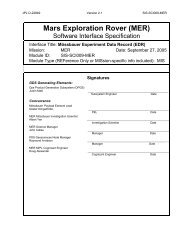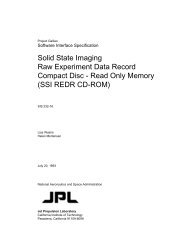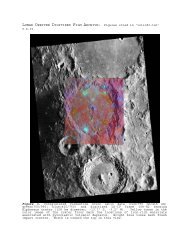SSI Raw Experiment Data Record (REDR) for Phase 2 - USGS PDS ...
SSI Raw Experiment Data Record (REDR) for Phase 2 - USGS PDS ...
SSI Raw Experiment Data Record (REDR) for Phase 2 - USGS PDS ...
Create successful ePaper yourself
Turn your PDF publications into a flip-book with our unique Google optimized e-Paper software.
Solid State Imaging <strong>Raw</strong> <strong>Experiment</strong> <strong>Data</strong> <strong>Record</strong> Software Interface Specification<br />
E-2<br />
Single-pixel spikes are stored as single pixels, data drop-outs, saturated pixels,<br />
and Reed-Solomon overflow records are stored as line segments, and low-fullwell<br />
pixels as column segments.<br />
Note: For compressed image data, all pixels to the right of the first bit error<br />
will be corrupted. Since it is not possible to determine where this bit error<br />
occurs, the entire line is flagged as bad.<br />
Each record will be in 16-bit integer data <strong>for</strong>mat and will contain only one type<br />
of object. The first three integers of each record contain the record ID, object<br />
code (CODE), and the number of objects in the record (N), respectively. The<br />
remainder of the record will contain a sequence of N objects. The maximum<br />
number of objects which can be stored on a record is a function of the EDR record<br />
length and object code. Full-frame and summation-mode EDRs have record<br />
lengths of 1800 bytes and 1000 bytes, respectively:<br />
Code<br />
Full-Frame<br />
Max. Objects<br />
1 448 248<br />
2 299 165<br />
3 299 165<br />
Summation-Mode<br />
Max. Objects<br />
If more objects of a certain type exist, they are written on subsequent records.<br />
The records are not necessarily written in any particular order, although they<br />
must all precede the image line records.<br />
Example 1: Let a binary header record contain the sequence of integers<br />
6,1,3,211,104,322,111,401,233. The record contains single-pixel spikes (6)<br />
encoded as single-pixels (1). There are three objects encoded as line-sample<br />
coordinates: (211,104), (322,111), and (401,233).<br />
Example 2: Let a binary header record contain the sequence of integers<br />
4,2,2,110,216,105,789,420,381. The record contains saturated pixels (4) encoded<br />
as line segments (2). There are two objects. The first line segment is on line 110<br />
and from sample 216 to 320. The second line segment is on line 789 and from<br />
sample 420 to 800.<br />
Example 3: Let a binary header record contain the sequence of integers<br />
5,3,2,299,710,91,521,72,729. The record contains low-full-well pixels (5)<br />
encoded as column segments (3). There are two objects. The first column segment<br />
is on sample 299 and from lines 710 to 800. The second column segment is on<br />
sample 521 and from lines 72 to 800.<br />
The following is an example of a program which reads an image containing<br />
bad-data in<strong>for</strong>mation, does something with this in<strong>for</strong>mation, and outputs an<br />
image which does not contain any binary labels (all subroutines other than XV<br />
routines are fictitious):<br />
COMMON/HDRREC/RECORDID,CODE,NOBJECTS,SPIX(2,448)!Binary<br />
header record





